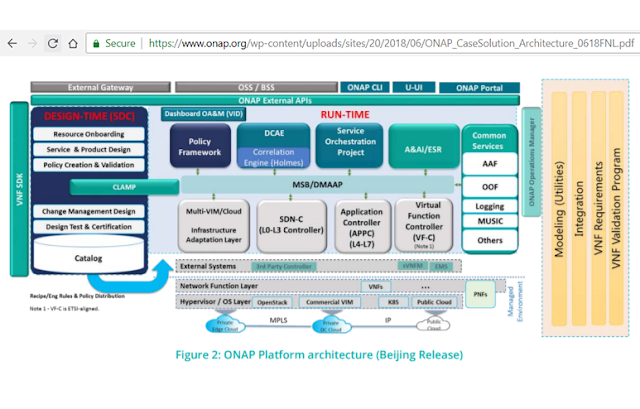Arm is recommitting and expanding its ambitions to supply processors for network and data center infrastructure. The renewed effort is inspired by the goal of building one trillion connected things by 2035 -- a figure cited by parent-company Softbank, whose multi-billion "Vision" fund invests in many start-ups across this ecosystem.

 At this week's ARMTechCon conference in San Jose, Arm outlined its "Neoverse Foundation", a dedicated infrastructure roadmap for infrastructure-class processor designs. The company is building a global ecosystem of software developers, equipment OEMs, service mobile operators (including sister company Sprint) and public cloud operators. Neoverse, which will also its brand identity for infrastructure processing, will extend from high-performance servers in hyperscale data centers, to mobile gateways, WAN routers, and new classes of products designed for the Edge Cloud.
At this week's ARMTechCon conference in San Jose, Arm outlined its "Neoverse Foundation", a dedicated infrastructure roadmap for infrastructure-class processor designs. The company is building a global ecosystem of software developers, equipment OEMs, service mobile operators (including sister company Sprint) and public cloud operators. Neoverse, which will also its brand identity for infrastructure processing, will extend from high-performance servers in hyperscale data centers, to mobile gateways, WAN routers, and new classes of products designed for the Edge Cloud.
While Arm is the established market leader in mobile devices, three generation of server CPU designs from its licensees have failed to capture significant market share versus Intel's Xeon processors. This time, the company says the market is ready because server designs are segmenting into specific workloads. Already we see GPU-powered cloud instances, TPU-powered servers and even servers optimized for in-memory database, video encoding, or streaming telemetry.
The Neoverse roadmap initially shows four designs all named after Greek gods. The current "Cosmos" design is implemented in 16nm. Next year, Arm will introduce its first Ares platform designs in 7nm. This will be followed by at least two further generations that bump up the performance by 30% with each iteration while targeting more specific workloads.
Previously, Arm licensees took the company's designs and then adapted them to their specific needs. In the server category, Cavium comes to mind with its multiple generations of ThunderX and ThunderX designs, which offered intriguing performance differentiators, but perhaps not enough to displace Intel in a meaningful way. While this market strategy remains in place, Arm is clearly aiming to deliver more complete designs with its Neoverse Foundation ecosystem.
In other infrastructure categories, Arm processors are already widely used. In fact, the company claims that 30% of top-of-rack (TOR) switches, 20% of mobile base stations, and 15% of gateways already include an ARM-licensed device. Neoverse should find some traction here.
So far, silicon companies listed in the Neoverse ecosystem include TSMC, Marvell, Broadcom, Ampere, Mellanox, Qualcomm, Samsung, NXP, Xilinx, Achronix, HuaXinTong, Cadence, Synopsys and Mentor.
Cloud ecosytem partners are Amazon's annapurnalabs, Microsoft Azure, Alibaba, Baidu, Tencent Cloud, and Packet.
Platform partners include HPE, Cisco, Ericsson, Huawei, Nokia, ZTE, Pegatron, Gigabyte, ENEA, and Telco Systems.

 At this week's ARMTechCon conference in San Jose, Arm outlined its "Neoverse Foundation", a dedicated infrastructure roadmap for infrastructure-class processor designs. The company is building a global ecosystem of software developers, equipment OEMs, service mobile operators (including sister company Sprint) and public cloud operators. Neoverse, which will also its brand identity for infrastructure processing, will extend from high-performance servers in hyperscale data centers, to mobile gateways, WAN routers, and new classes of products designed for the Edge Cloud.
At this week's ARMTechCon conference in San Jose, Arm outlined its "Neoverse Foundation", a dedicated infrastructure roadmap for infrastructure-class processor designs. The company is building a global ecosystem of software developers, equipment OEMs, service mobile operators (including sister company Sprint) and public cloud operators. Neoverse, which will also its brand identity for infrastructure processing, will extend from high-performance servers in hyperscale data centers, to mobile gateways, WAN routers, and new classes of products designed for the Edge Cloud.While Arm is the established market leader in mobile devices, three generation of server CPU designs from its licensees have failed to capture significant market share versus Intel's Xeon processors. This time, the company says the market is ready because server designs are segmenting into specific workloads. Already we see GPU-powered cloud instances, TPU-powered servers and even servers optimized for in-memory database, video encoding, or streaming telemetry.
The Neoverse roadmap initially shows four designs all named after Greek gods. The current "Cosmos" design is implemented in 16nm. Next year, Arm will introduce its first Ares platform designs in 7nm. This will be followed by at least two further generations that bump up the performance by 30% with each iteration while targeting more specific workloads.
Previously, Arm licensees took the company's designs and then adapted them to their specific needs. In the server category, Cavium comes to mind with its multiple generations of ThunderX and ThunderX designs, which offered intriguing performance differentiators, but perhaps not enough to displace Intel in a meaningful way. While this market strategy remains in place, Arm is clearly aiming to deliver more complete designs with its Neoverse Foundation ecosystem.
In other infrastructure categories, Arm processors are already widely used. In fact, the company claims that 30% of top-of-rack (TOR) switches, 20% of mobile base stations, and 15% of gateways already include an ARM-licensed device. Neoverse should find some traction here.
So far, silicon companies listed in the Neoverse ecosystem include TSMC, Marvell, Broadcom, Ampere, Mellanox, Qualcomm, Samsung, NXP, Xilinx, Achronix, HuaXinTong, Cadence, Synopsys and Mentor.
Cloud ecosytem partners are Amazon's annapurnalabs, Microsoft Azure, Alibaba, Baidu, Tencent Cloud, and Packet.
Platform partners include HPE, Cisco, Ericsson, Huawei, Nokia, ZTE, Pegatron, Gigabyte, ENEA, and Telco Systems.
















